When my illustrator, R.J. (Becky) Hughes, had the idea of framing the pages in Catherine’s Pascha with images of Orthodox churches from around the world, she wanted to have at least one church from every continent: Africa, Asia, Australia, Europe, North America, South America, and, yes, Antarctica. She wanted churches that were historically important, or especially beautiful, or interesting in some way.
Here are the churches she chose, with a little bit of information about each of them.
Orthodox churches in Africa
The history of Christianity in northern Africa begins in the first half of the first century AD. Even so, the Orthodox churches in Africa had no significant presence south of the Sahara until the twentieth century. There are now 17 Orthodox archdioceses and dioceses in sub-Saharan Africa under the Patriarchate of Alexandria. Four Orthodox churches in Africa appear in the pages of Catherine’s Pascha.
All Saints Church at the Diocesan Seminary, Kasikizi, Tanzania
The All Saints Church at the seminary in Kasikizi, Tanzania, is the sister parish of All Saints Greek Orthodox Church, Canonsburg, Pennsylvania.
In a homily in 2001, Father George Livonas of All Saints, Pennsylvania, made an off-the-cuff remark about how little it would cost to build a church in Africa. At coffee hour, the leaders of the Philopthochos Society told him that, if he built the church, they would support the priest through the Orthodox Christian Mission Center.
A few weeks later, he learned that there were plans for a church in Tanzania. And then Father George was asked if his parish would host Bishop Jeronymos of Tanzania on his speaking tour around the US. It looked like God intended All Saints, Pennsylvania, to help build All Saints, Tanzania. And, indeed, that is exactly what came to pass.
Father George was blessed to be at All Saints, Tanzania, when it was consecrated by Bishop Jeronymos. You can find the rest of the story here.
Sacred Monastery of the God-Trodden Mount Sinai (St. Catherine’s Monastery), Sinai, Egypt
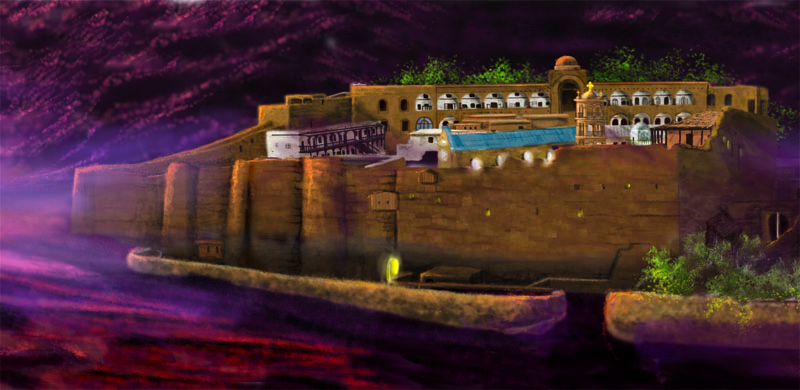
The Greek Orthodox Monastery of the God-Trodden Mount Sinai is where Moses met God in a bush that burned but was not consumed.
The monastery was built between 548 and 565, by the order of the Emperor Justinian I. The date of the church is established by inscriptions carved into the beams of the church. One says, “For the salvation of our most august emperor Justinian.” The other says, “For the memory and repose of our departed empress Theodora.”
The church was therefore built no earlier than 548, the year when Theodora died. In 556, the church is mentioned in the writings of Procopius, so the church was completed by that date. The Emperor Justinian and Empress Theodora are still commemorated in every Liturgy served at the monastery.
The monastery church was originally dedicated to the Transfiguration. When the remains of St. Catherine were discovered in 800, and taken to the Church, the church was rededicated to her. The monastery is now usually known by her name.
St. Catherine’s is the oldest Christian monastery still in use as a monastery. The thick, high walls ordered by Justinian protected it from every attack for many centuries.
The Monastery has always maintained close relations with Islam. In 623 a document known as the Actiname was drafted and signed by Mohammed. The document spelled out certain privileges for the monks of St. Catherine’s and obligated Muslims to help and protect them. The monks converted a chapel to a mosque during the Fatimid Caliphate. Unfortunately, the mosque was not oriented properly towards Mecca, so it was never used.
More information about St. Catherine’s Monastery is available on the monastery’s website.
The Church of St. George, Cairo, Egypt
The Church of St. George was built in the 10th century on top of a Roman tower. As a result, rather than having a cruciform shape, as most Orthodox churches do, it is round. It took its shape from the tower it was built on. It is the only round church in all of Egypt, and one of very few in the world. (Interestingly, St. George Church in Brasilia is also round.)
The stairs that lead up to the church are built on the outer wall of the Roman tower. As you walk up the stairs, you see a relief of St. George and the dragon that is worked into the outer brickwork of the tower.
According to tradition, when Mary and Joseph fled to Egypt with the child Jesus, they took shelter in the place now covered by the Church of St. George.
The Church is the see of Greek Patriarch of Alexandria. It is adjacent to the Monastery of St. George, a women’s monastery that houses the wonder-working chains of St. George.
The Church of Our Lady Mary of Zion, Axum, Ethiopia
The Church of Our Lady Mary of Zion is the most important church in Ethiopia. The Ark of the Covenant is believed by many to be housed there. No one but a single guardian monk is permitted to enter the chapel where the Ark rests. When the guardian monk is selected, he stays with the Ark for the rest of his life.
The original Church of Our Lady Mary of Zion was built during the fourth century, during the reign of the first Christian emperor of Ethiopia. It is thought to have been destroyed in the 10th century by Queen Gudit. It was destroyed again in the 16th century, and rebuilt by the emperor Gelawdewos.
As with Mount Athos, it was believed that the Theotokos resides in a particular way at the Church of Our Lady Mary, and therefore no other women are permitted in the Church. However, in the 1950s, the Emperor Haile Selassie built a new cathedral of the same name, which is adjacent to the old church. The new building is open to both women and men.
Orthodox churches in Antarctica
It might seem incredible, but there are in fact seven churches in Antarctica, including two Orthodox churches. One of the two appears in Catherine’s Pascha.
Holy Trinity Church, King George Island, Antarctica
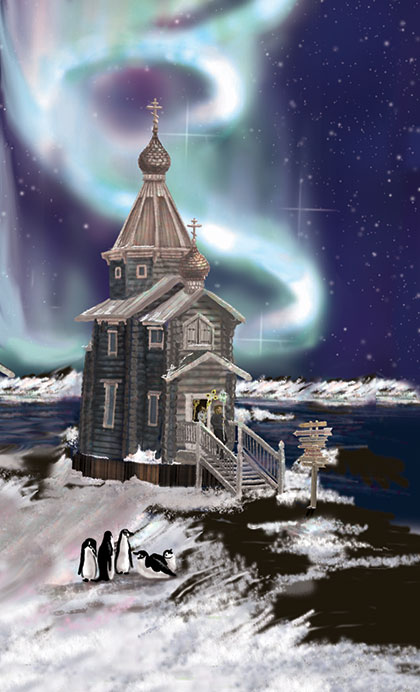
Built in the traditional Russian style, Holy Trinity Church is the southernmost Orthodox Church in the world. The tiny church can accommodate as many as 30 worshippers. It is served year-round by one or two hieromonks from the Trinity Lavra of St. Sergius in Russia. The principal duty of the clergy, besides celebrating the regular services of the Church, is to pray for the souls of the 64 Russians who have died in Antarctica. As need arises, they also perform baptisms in the Southern Ocean, and occasionally perform weddings.
Orthodox churches in Asia
Asia is home to the most ancient Orthodox churches in the world and the newest. They can be found from the Middle East through the Indian subcontinent to the islands of Japan. Five of the Asian churches are included in Catherine’s Pascha.
Holy Resurrection Cathedral (Nikolai-Do), Tokyo, Japan

Holy Resurrection, the main cathedral of the Orthodox Church in Japan, is better known by its nickname, Nikolai-do, the House of Nicholas. This Nicholas is St. Nicholas, Equal to the Apostles and Enlightener of Japan. He first came to Japan to serve the Russians living there. He learned the Japanese language and stayed to serve the Japanese people. Once he was consecrated bishop, he built his cathedral on a hill overlooking the Imperial Palace in Tokyo, and called it Holy Resurrection Cathedral. The people of Tokyo, though, called his cathedral by his name.
Work on the church began in 1884, according to a traditional Byzantine design by Michael Shchurupov, an architect from Moscow. Work was completed and the church was consecrated in 1891. Shchuropov’s design, however, could not withstand the Great Kanto Earthquake of September 1923. The earthquake brought down the main bell tower onto the central dome, collapsing it, and fire destroyed the interior of the building. The cathedral was rebuilt using plans by the Japanese architect Shinito Okada. Okada’s design was more fitting for an area with the potential for great earthquakes, and it was closer to what St. Nicholas himself had wanted. It had a shorter bell tower, a modified dome, and a less ornate interior. The new cathedral was consecrated in 1929.
If you try to visit Nikolai-do and find the main building closed, look for the small building adjacent to the cathedral that’s open all the time where you can light candles and pray.
Mariamite Cathedral of Damascus, Damascus, Syria
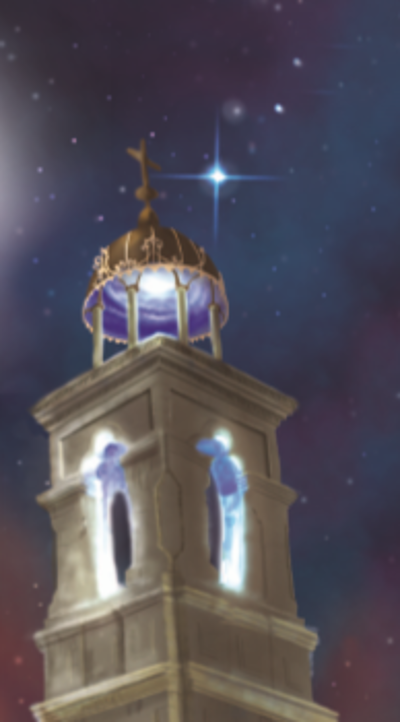
The original Mariamite Cathedral was built during the second or third century. It is one of the oldest churches in Damascus, located on the Street Called Straight, which St. Paul is said to have visited in the Acts of the Apostles.
After the Muslim conquest of Damascus in 634, the church was closed. It was returned to the Christians in 706 by the Umayyad caliph Al-Walid. In 1342, the Patriarchal See of Antioch relocated to Damascus, and the Mariamite Cathedral became the seat of the Antiochian Orthodox Church.
The church has been destroyed and rebuilt many times. The current building includes renovations from 1953, to repair damage done in anti-Christian riots in 1860.
The Church of the Holy Life-Giving Trinity, Phuket, Thailand
In the year 2000, the Russian Orthodox priest Archimandrite Oleg Cherepanin arrived in Bangkok. Father Oleg was the first Orthodox priest in Thailand, and he began translating the Holy Scriptures and service books into Thai.
In 2008, the Orthodox Church was officially recognized by the Thai government, and in 2009, planning began for the Church of the Holy Life-Giving Trinity.
The church was intended to be the first Orthodox church in Thailand. A financial crisis intervened, however. By the time the church was completed in 2012, three other Orthodox churches had already been built in other parts of the country.
As with the other Orthodox churches in Thailand, the parish is ethnically diverse. In addition to Russians and Thais, there are parishioners from Bulgaria, Romania, France, America, and various countries in Africa.
The Church of the Holy Sepulchre, Jerusalem
Visitors to the Church of the Holy Sepulchre are sometimes disappointed by what they see when they arrive. This holiest of churches is not a grand and majestic edifice. Rather, it is a conglomeration of structures of varying ages and styles.
Architectural elements reflect the long and complex history of the site. Byzantine, medieval, Crusader, and modern styles seem to be thrown together haphazardly. Each of the Christian communities that control portions of the church has introduced distinctive decorations for their area that may clash with their neighbors. Nearly everything is in need of renovation and repair.
And yet the Church remains the holiest of holy sites. It encompasses both the site where Jesus was crucified and the site where He was buried. Christians in the first and second century were already worshiping at the site. The Emperor Hadrian, in an attempt to wipe out this worship, flattened the site and built a temple to Venus there.
This conveniently marked the spot, and ensured that, in the future, it would be easy to find. When the first Christian emperor, Flavius Constantinus, allowed the church to be built, the Christian community knew exactly where to put it.
According to tradition, Constantine arranged for the rock around the tomb to be excavated. A small building called the Edicule (or, in Greek, the Kouvouklion) was built in the Rotunda to enclose the tomb.
From that time until this, the history of this Church has only gotten more complicated and more chaotic. As part of the Old City of Jerusalem, it is a UNESCO World Heritage site.
The Church of the Seven Apostles, Capernaum, Galilee, Israel
The Church of the Seven Apostles takes its name from a passage in the Gospel of John when Jesus, after his Resurrection, appeared to Simon Peter, Thomas, Nathanael, James, John, and two other disciples. The church is also called the Church of the Twelve Apostles, in reference to the Gospel account of Jesus choosing the Twelve Apostles in this area of Galilee.
The church was built in 1931 on the edge of the Sea of Galilee. It’s in the north-eastern part of the ancient village of Capernaum, where villagers moved after the old town was destroyed, either in an earthquake in 749, or perhaps by some other event in the 8th century.
The village had been in ruins for many centuries when the Greek Orthodox Patriarchate of Jerusalem bought the site and built the church. The church had not been in use long when Israel’s War of Independence in 1948 put the church in a demilitarised zone between Israel and Syria. Christians had no access to this zone, and so their church and the adjacent monastery stood empty. Druze residents began using the church as a barn.
After the Six Day War in 1969, Greek Orthodox Church took possession of the church once again. The church has since been completely restored.
Orthodox churches in Australia
The first Divine Liturgy in Australia was celebrated in 1820. Today, there are nearly 250 Orthodox churches in Australia, with more than half a million members. One of these churches appears in Catherine’s Pascha.
St. Elijah Serbian Orthodox Church, Coober Pedy, South Australia
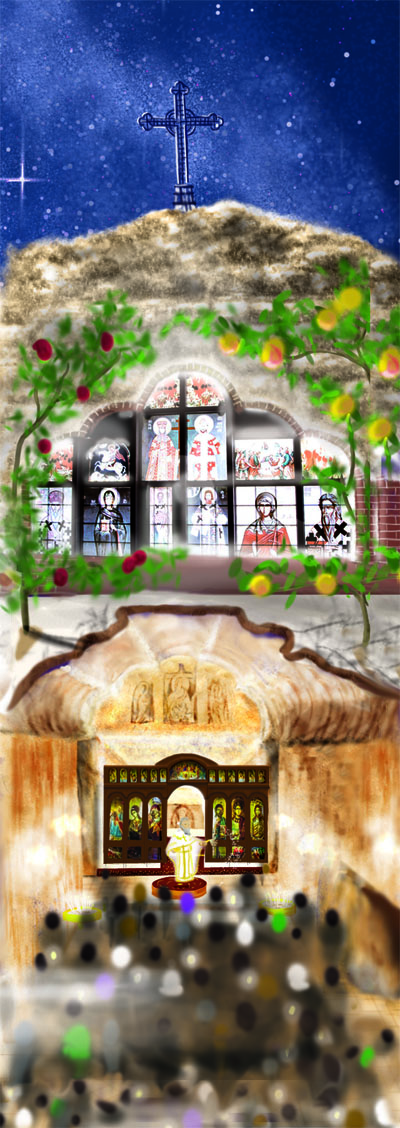
Opal was discovered in Coober Pedy 100 years ago. It was an inhospitable area, where daytime highs in January average near 100°F, and rain is a scant 5 inches a year.
But opal mines required miners, and miners required homes. Most homes in Coober Pedy are built into the ground, where they are protected from the blazing heat.
And when the Serbian people in Coober Pedy decided to build a church, they built it the same way. The church is carved 30 feet into the ground. Even the icons on the walls are carved into the stone. The windows that are on ground level on the outside soar 20 feet over the nave. The icons on the iconostasis are written on glass and lit from behind.
Orthodox churches in Europe
Orthodox Christianity is the majority faith in much of Eastern Europe and in Greece. It may not be as well known in countries like England or Finland, but there have been Orthodox churches in Western Europe from the earliest days of Christianity. Five European churches, from both East and West, appear in Catherine’s Pascha.
Hagia Sophia, Constantinople (now Istanbul), Turkey
The Emperor Constantine built his great cathedral, Hagia Sophia, in 360 AD, in Constantinople, the capital city of his new, Christian empire. The cathedral was on the highest point of the city, on the European side of the Bosphorus Strait.
Hagia Sophia was dedicated, not to Saint Sophia, as some suppose, but to the Holy Wisdom of God, the Logos, the Second Person of the Trinity. The feastday for the church was December 25, the feast of the Nativity.
The current building is actually the third building for the church. It was built by Justinian I between 532 and 537 AD to replace the second building, which was burned to the ground during the Nika Revolt. The original Hagia Sophia had been built in 360. It was destroyed in the year 404, during riots that erupted when St. John Chrysostom was exiled.
After the fall of Constantinople in 1453, Hagia Sophia was converted to a mosque. In the early 1930s, it became a museum. In 2020, Turkey’s Council of State designated it as a mosque once again, over the protests of UNESCO, the World Council of Churches, and many others.
The illustration of Hagia Sophia in Catherine’s Pascha shows the church before it became a mosque. A peacock, an early Christian symbol of the Resurrection, is perched on the roof of the baptistry.
St. Sophia’s Orthodox Cathedral, London, England
The first Greek Orthodox Church in London was built in 1677. Soon, however, the Greeks living in London began moving to a different part of the city, and the church fell into financial difficulties. By 1684, French Huguenots had taken possession of the building.
For many years after that, the Greeks of London worshiped in the Russian church. It wasn’t until 1837 that a Greek chapel was built. That chapel was dedicated to Christ the Savior. But the Greek community was growing, and by 1843, the chapel was already too small for the community.
A new church of Christ our Savior was completed in 1849. Again, though, the people in the Greek community began to move to other areas of the city, and the location of Christ the Savior church was too far away from the community to be practical.
In 1874, the church established a building committee; in 1877, the foundation stone for the new building was laid, and in 1879, a new building was completed. The church is known as St. Sophia, dedicated, not to a saint, but to the Holy Wisdom of God.
St. Sophia has been the cathedral of the Metropolis of Thyateira and Great Britain since 1922. During World War II, when London was the seat of the Greek government in exile, St. Sophia also served as the cathedral of the Greek nation.
The cathedral was bombed during the Blitz, and was later repaired. The St. Sophia cathedral website has more about the church, along with images of the magnificent mosaic icons that adorn the walls.
St. Basil’s Cathedral, Moscow, Russia
The church known throughout the world as St. Basil’s Cathedral is officially the Church of the Protecting Veil of the Mother of God, or sometimes the Cathedral of the Intercession of the Most Holy Theotokos on the Moat. It was built in the mid-sixteenth century by Ivan the Terrible to commemorate his military triumphs in Kazan.
There is no other building like it. In more than a thousand years of Russian and Byzantine art and architecture, there is nothing similar. Historians argue about possible influences — wooden churches in northern Russia, mosques in Kazan, Greek refugees from Constantinople, and Italian and German craftsmen. This mix of influences resulted in a building that is unique.
The cathedral is not one church, but eleven. The original design called for the central church to be surrounded by four large churches and four smaller ones. The entire structure is asymmetrical; the large apse of the main church causes it to be offset to the west.
The asymmetry is increased by the tenth and eleventh chapels, which were not in the original plan. The tenth chapel is built over the grave of St. Basil the Holy Fool, who was an open adversary of Tsar Ivan. St. Basil left his original work as a shoemaker to take up shoplifting. He gave what he stole to the poor, both to help those in need and to shame the rich who could have helped but did not.
Basil also rebuked the tsar publicly for lack of piety and for his violence and brutality. When Basil died, the tsar served as one of his pallbearers. The name of the monumental cathedral that was built at the tsar’s command has, ever since, been known by the name of St. Basil.
The final chapel was originally dedicated to the protection of the Mother of God. Since 1916, though, it has served as the grave of St. John the Blessed of Moscow, and is dedicated to him.
St. Spiridon and the Church of the Resurrection, Oia, Santorini, Greece
Santorini is the largest of a group of islands that surround the caldera of an ancient, but still active, volcano in the Aegean Sea. The conditions on the island can be harsh. Many local homes, called yposkafa, are carved into cliffs. This protects the homes from the heat of summer and from storms and earthquakes.
The village of Oia is perched on cliffs. It is home to some 70 churches. The white-washed, blue-domed churches are instantly recognizeable, even if you’ve only seen photographs. St. Spiridon and the Church of the Resurrection are the main churches in the Monastiri district.
Cathedral of Christ the Savior, Moscow, Russia
In 1812, after Napolean Bonaparte retreated from Moscow, Tsar Alexander I declared his intention to build a magnificent cathedral in honor of Christ the Savior. Work on the cathedral was begun by his successor, Nicholas I, in 1839.
The construction took many decades to complete. The cathedral was not consecrated until May 26, 1883, the day before Alexander III was crowned.
Tchaikovsky’s 1812 Overture was written in honor of the cathedral and of the victory of Tsar Alexander over Napolean. It premiered in a tent outside the unfinished church in August 1882.
The cathedral was destroyed in 1931, under Joseph Stalin, ostensibly to extract the gold from the domes. A gigantic Palace of the Soviets was to have been built there, but the foundation was, for many years, nothing more than a giant water-filled pit. A swimming pool was eventually installed.
The church, a faithful replica of the original, was rebuilt in the 1990s. At 338 feet in height, it is the tallest Orthodox Church in the world.
Orthodox Churches in North America
Cultural diversity has been a major feature of the Orthodox churches in North America since the first Russian missionaries arrived in Alaska in 1794. This diversity is apparent in the five North American Orthodox Churches that appear in Catherine’s Pascha.
Holy Resurrection Church, Kodiak Island, Alaska
R.J. Hughes, illustrator of Catherine’s Pascha, shared this:
In Catherine’s Pascha, you see the current Holy Resurrection Church in Kodiak, Alaska, with a small wooden chapel in front of it. The small chapel is the first church on that site for that congregation.
I had seen pictures of the church, and when I read it was founded in 1796, I thought, “That’s an awfully modern looking building if it’s over two hundred years old.”
A little research revealed the truth: there have been at least three churches (some sources say four) for that congregation in roughly the same spot–that small wooden one, a second that was built in the 19th century and burned down in 1942, and the current one.
When the St. Herman’s Theological Seminary was founded, they constructed their log chapel (All Saints I believe it’s called) as an exact replica of the church St. Herman and his brothers built in the late 1700s.
Long story short, I did WAY too much research for the time I had, and fell in love with the story of how the Russian monks came to Alaska in the wake of the Russian traders and defended the people of Alaska, both the native born and the immigrants from Russia, and how the church grew from there.
Seeing as St. Herman is the patron saint of North America, I chose that church for the book to pair with Holy Trinity in Antarctica. But I wanted to pay homage to the original history of the church in that small, gorgeous, log cabin, so I placed it in front and below the current church towering above. So the wooden building in that illustration is both an homage to the original chapel for Holy Resurrection, and it’s the current chapel at St. Herman’s seminary. Kind of like an icon, in that things that took place at different times be within an icon to tell the story. I actually wanted to do that for Hagia Sophia, but no one knows what the original church looks like, and we only have pieces of the second. And Holy Sephulcre was difficult enough without trying to weave the earlier churches into it!
Annunciation Greek Orthodox Church, Wauwatosa, Wisconsin
Annunciation Greek Orthodox Church was one of the last buildings designed by famed American architect Frank Lloyd Wright. The design work was begun in 1956, and construction of the church was completed in 1962, three years after Wright’s death.
Wright understood that he could not be as innovative in the design of an Orthodox church as he was in the design of the Guggenheim Museum, New York, which he worked on from 1946 thorugh 1959. He drew on Byzantine architectural traditions, most especially the design of Hagia Sophia, in developing the design of Annunciation.
In addition, his wife, an Orthodox Christian, had told him that the most important aspects of Orthodox church architecture are the cross and the dome. He took these as themes for his design, and interpreted them in a way that was uniquely modern and American.
The church is on the National Register of Historic Places. The parish website includes more information about the church.
Holy Trinity Greek Orthodox Cathedral, New Orleans, Louisiana
Orthodox Christians had been immigrating to America from Greece, Russia, Serbia, and Syria since the eighteenth century. As the number of Orthodox Christians increased, the need for churches became more intense.
In 1860, the Greek consul in New Orleans, Nicholas Benachi, began efforts to organize a church. The Orthodox faithful in the area came together as a worshiping community in 1864, and their first building, Holy Trinity Church, was built in 1866. It was the first Greek Orthodox Church in the New World.
By 1950, the church was far too small for the parish. The building was demolished and replaced with a larger building. In 1960, 100 years after Benachi’s first efforts towards founding an Orthodox Church in New Orleans, Holy Trinity was consecrated as a cathedral. In 1976, the original church property was sold. The new cathedral on Bayou St. John was completed in 1985 and consecrated in 2001.
Holy Trinity appears to be the only Orthodox cathedral where you can arrive for liturgy by kayak or canoe. Read more about Holy Trinity Cathedral and their annual Greek Festival on their website.
Church at the Monastery of the Holy Trinity, Lake Amatitlán, Guatemala
The Monastery of the Holy Trinity is a monastery for women under the jurisdiction of the Patriarchate of Antioch. The monastery, which supports an orphanage and the only Orthodox church in Guatemala, was founded in April 1986 by Mother Inés and Sister María Amistoso.
Mother Inés was a member of a Roman Catholic monastic order until 1986, when she converted to Orthodoxy and became an Orthodox nun. In 1989, her monastery was given land high on a hill. The land is a little more than 12 miles from Guatemala city, near Lake Amatitlán and near Pacaya, an active volcano.
Although the monastery is under the patriarchate of Antioch, their church is built in the Russian style. Mother Inés says that, when people see the onion domes, they know that they are looking at an Orthodox church. The parish also follows the Russian rubrics in their services, and keeps the Old Calendar.
The bird flying near the monastery church in the illustration in Catherine’s Pascha is a resplendent quetzal, the national bird of Guatemala.
St. Demetrios Greek Orthodox Church, Winnipeg, Manitoba, Canada
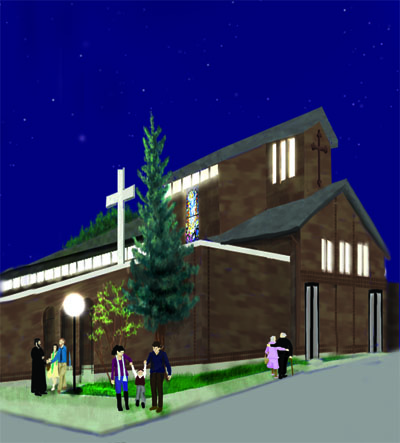
The first Orthodox Christian in Winnipeg, Tom Julius, arrived in Winnipeg from Laconia, Greece, in 1898. Over the next few years, more Greeks arrived. The first official Greek Association was established in Winnipeg in 1912, and was restyled the Greek Community of Winnipeg in 1917. This group served as a hub for the tiny Greek community in Winnipeg.
In 1923, the first Greek Orthodox priest arrived in Winnipeg. Sacraments could now be served. In 1926, the Greek women in the community established a philanthropic association. By 1934, the Greek Community had 44 members.
In 1957, a church was built and dedicated to St. Demetrios. The church soon outgrew that location, and in 1973, the new church was dedicated.
R.J. Hughes, the illustrator of Catherine’s Pascha, explains why she chose St. Demetrios for the book.
Orthodox churches in South America
There have been Orthodox churches in South America since the late 19th century, primarily in major cities. Two of these churches appear in Catherine’s Pascha.
St. George’s Orthodox Church, Brasilia, Brazil
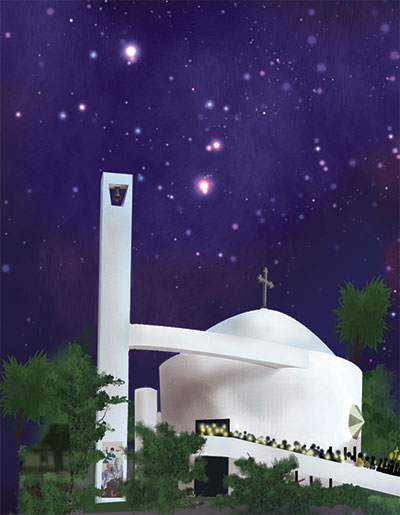
When Juscelino Kubitschek became president of Brazil in 1956, he wanted to build a new city from the ground up, to serve as the capital of the country. Lúcio Costa, a highly regarded architect and urban planner, was chosen to create the layout of the city, and Oscar Niemeyer to design the buildings.
Niemeyer was considered one of the greatest architects of his generation. His work was famous for the use of curves, the shapes of rivers and ocean waves. “Curves make up the entire Universe,” he said in his memoirs, “the curved Universe of Einstein.”
His work in the creation of Brasilia included a major cathedral. St. George’s Church came much later, in the 1990s. The building reflects Niemeyer’s love of curves: The church is a cylinder topped with a dome, about 100 feet across. From a distance, it looks like a great white egg.
Cathedral of the Most Holy Trinity, Buenos Aires, Argentina
The star-spangled blue onion domes of the Russian Orthodox Cathedral of the Most Holy Trinity are an unexpected sight in the San Telmo neighborhood in Buenos Aires. The building was designed in the late 19th century by Alejandro Christophersen, an Argentine architect of Norwegian descent.
The Cathedral is considered one of his most important works. Orthodox Christians had begun arriving in South America in the middle of the 19th century. Sailors and merchants from Greece, Syria, Lebanon, and the Slavic countries settled in Argentina. And yet there was not a single Orthodox church in all of South America.
In 1887, a group of Orthodox Christians, both Russian and Greek, petitioned Tsar Alexander III of Russia to provide a church. At that point, work on the church began in earnest. Clergy were sent, and the first divine Liturgy in South America was held in 1889. Construction of the church began in 1898 and was completed in 1901.
The church was, from the very beginning, a multi-ethnic parish. The fall of the Russian empire, however, resulted in the church fragmenting along ethnic lines, in much the same way as it did in the United States. Because of the political situation in Europe, Orthodox Christians of Greek and of Syrian and Lebanese descent formed their own parishes with their own national priests. Nevertheless, all of the Orthodox churches in South America continue the close relationships that reflect their united origins.
Read More
17 ways to use Catherine’s Pascha: Cooking, crafts, and other activities to extend the book and create joy with your children.
Icons in Catherine’s Pascha: Illustrator R.J. Hughes provides some background information about the icons in Catherine’s Pascha.
The complete list of multicultural Easter picture books: There aren’t nearly as many books as you’d expect that show people celebrating the Resurrection of Christ. This list includes (almost) all of them!
Books by Charlotte Riggle

This holiday classic shares the joy of Pascha through the eyes of a child. Find it on Amazon or Bookshop.org.
![]()
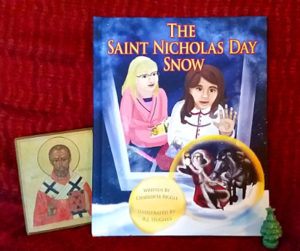
This delightful story is filled with friendship, prayer, sibling squabbles, a godparent’s story of St. Nicholas, and snow. Lots and lots of snow. Find it on Amazon or Bookshop.org.
![]()
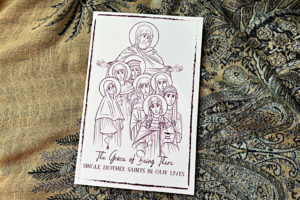
In this collection of essays, women who are, or have been, single mothers share stories of their relationships with saints who were also single mothers. Charlotte’s story of the widow of Zarephath highlights the virtue of philoxenia. Find it on Amazon or Park End Books.


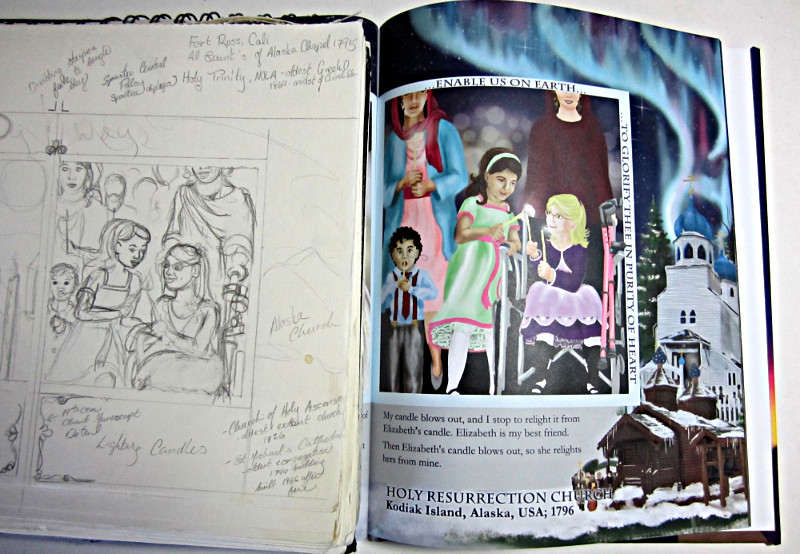
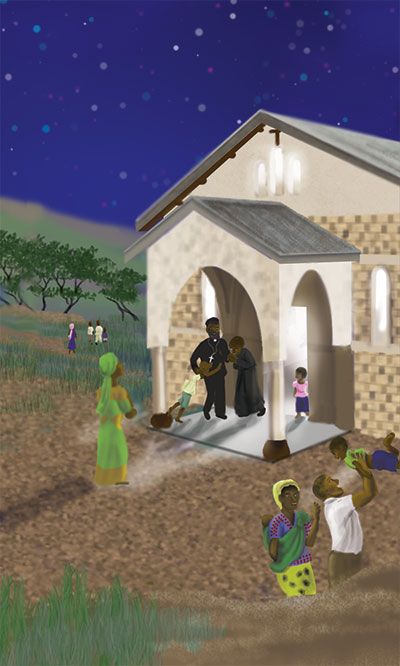

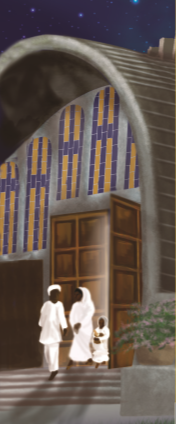
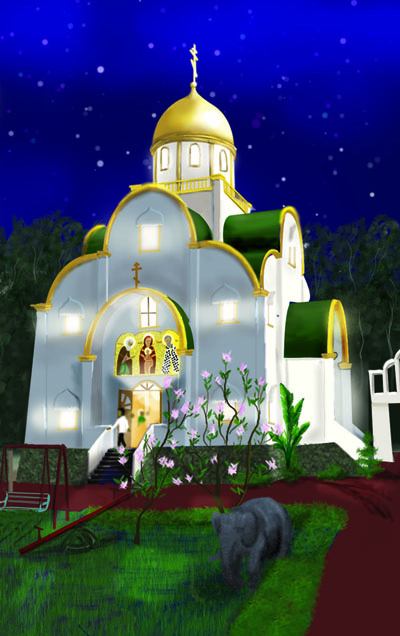
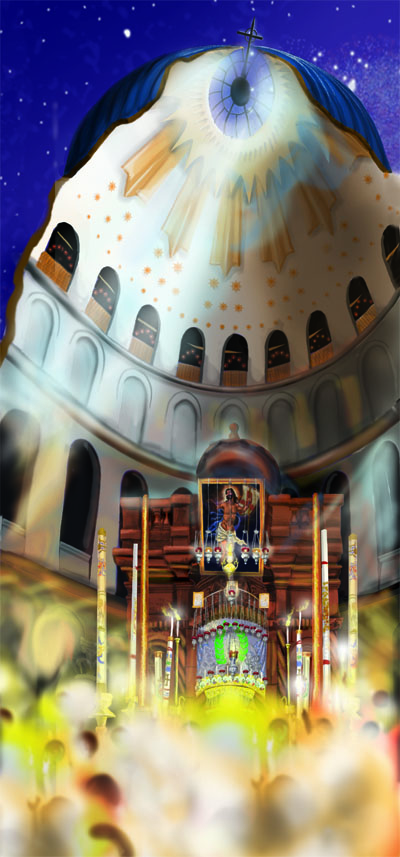

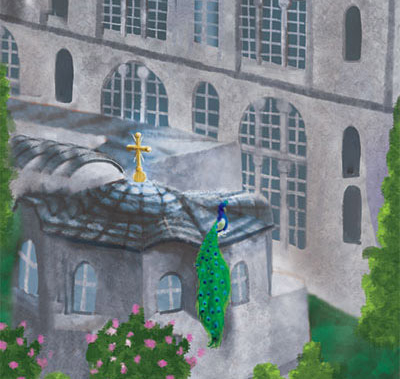




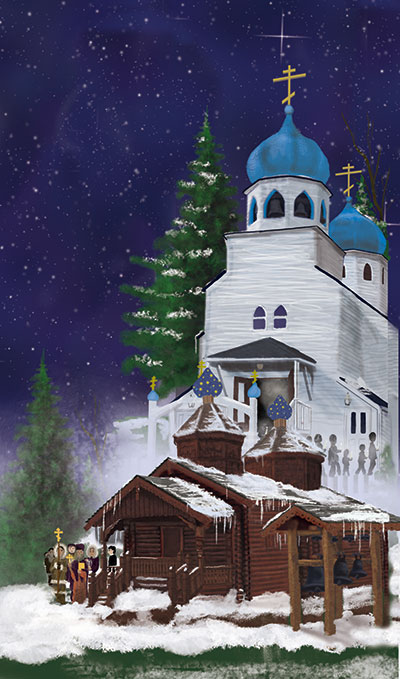
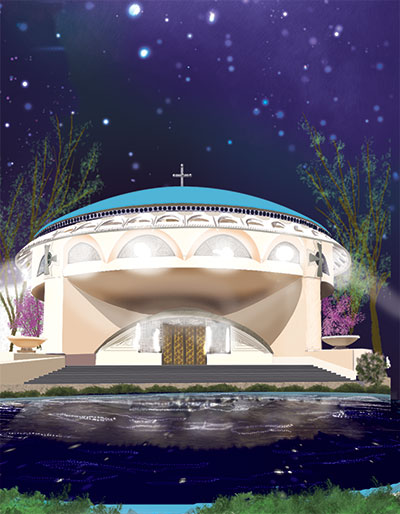
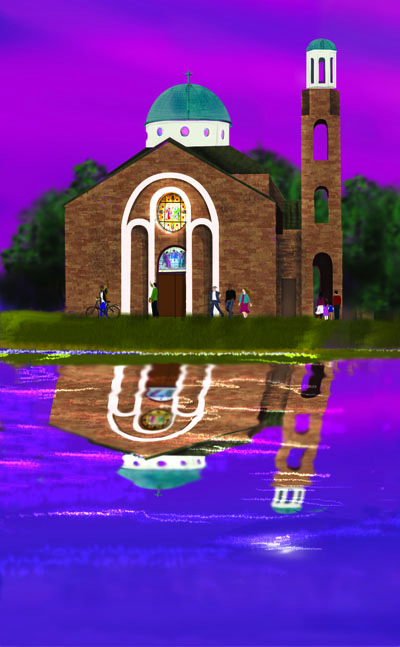




What country does Catherine’s Pascha take at? The story of herself, her family and her wheelchair friend?
Hi, Thomas! Catherine’s Pascha takes place somewhere in the United States.